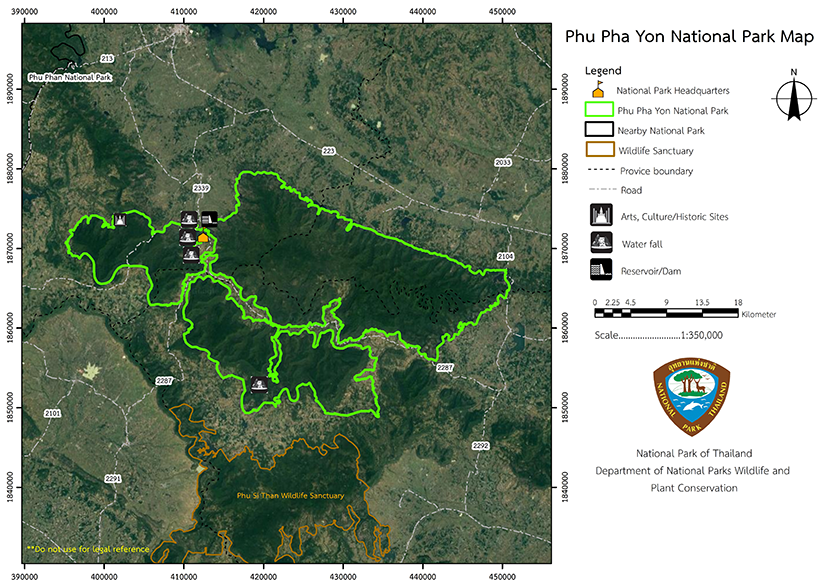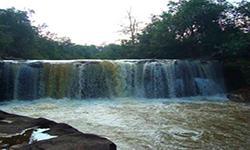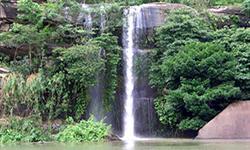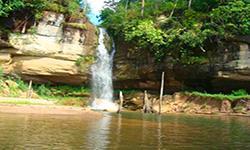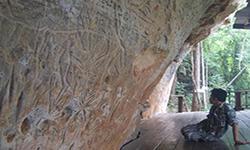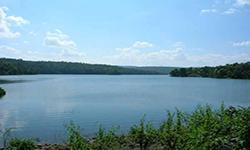Phu Pha Yon National Park
Contact Location : Phu Pha Yon National Park, Ban Huai Huat, Chan Phen Sub-district, Tao Ngoi District, Sakon Nakhon Province, 47260
Telephone Number : (+66) 4 270 7214, (+66) 8 1965 3507, (+66) 8 1260 4988, (+66) 9 1065 6909
Email : phuphayon@hotmail.com
Facebook : Phu Pha Yon National Park
Background
The Royal Forest Department received a letter no. Ko So 0301/So 524 from the Royal Irrigation Department dated December 20, 1984, informing that on the occasion of His Majesty the King Bhumibol Adulyadej's visit to the Huai Huat Reservoir Project in Tao Ngoi Sub-district, Tao Ngoi Minor District, Sakon Nakhon Province on November 27, 1984 and said that , "should protect the natural conditions and forests near the the Huai Hua reservoir impoundment dam as well as the areas around the reservoir, along with improving the area to be beautiful and suitable for developing or promoting as a National Park or as a tourist attraction. The Royal Irrigation Department and relevant government agencies therefore have to jointly take urgent action on this. The Royal Irrigation Department thus requested the cooperation from the Ministry of the Royal Forest Department to take urgent action on the nature and forest protection project in the region and establish it as a National Park or tourist attraction in response to His Majesty's initiative.
The National Parks Division,on January 14, 1985, sent a letter No. Ko So 0713/140 to assign the Phu Phan National Park to conduct a survey on the area. It was found that the area is an abundant natural forest, the source of the watersheds, and has naturaland beautiful scenery. According to the document issued by Phu Phan National Park no. Ko So 0713 (Pho Pho), /144, dated March 27, 1985, based on a preliminary survey report on the area written ty Mr. Manop Kamjornjerd, a Foresty Technical Officer Level 4, and the document issued by Phu Phan National Park No. Ko So 0713 (Pho Pho)/532, dated December 17, 1985, providing the details
about the areas which is written by Mr. Wuttikarn Ampholsak, a Landscape Architect. The National Park Division sent a letter No. Ko So 0713/405 dated January 28, 1986 assigning Phu Phan National Park to explore the forest condition again. Then, Phu Phan National Park issued a document No. Kor Sor 0713 (Po Po)/Special dated February 6, 1986 to report the results of a survey to prepare for the establishment of a national park, which was written by Mr. Pramuk. Thichakorn, a Forestry Technical Officer Level 5, to the National Park Division to carry on establishing a national park.
The National Park Division, Royal Forest Department, has presented to the National Park Board. It was resolved in the meeting No. 2/2529 on March 18, 1986, to agree in principle to organize the forest area above the Huai Huat Reservoir as a National Park. and as a national park project for the purpose of honoring His Majesty the King on the auspicious occasion of His Majesty the King's 5th cycle birthday, December 5, 1987. The royal decree specified the areas of Phu Lom Khao and Phu Phek Forests in the Tong Khop and Lao Phon Kho Sub-district, Si Suphan Minor District, Mueang Sakon Nakhon District, Kok Pla Sio Sub-district, Mueang Sakon Nakhon District and Chan Phen, Tao Ngoi and Tao Ngoi Sub-district, Mueang Sakon Nakhon District, Sakon Nakhon Province Dong Phu Phan Forest in Nong Bo, Kham Phi, Kan Lueang, Ban Kaeng, Na Kae and Phiman Sub-district, Na Kae District, Nakhon Phanom Province and Kok Tum, Fang Daeng and Dong Luang Sub-district, Dong Luang District, Mukdahan Province and Dong Phu Si Than Forest in the area of Kham Cha-I Sub-district, Mukdahan Province, Ban Lao,Ban Kho and Phon Ngam Sub-district, Kham Cha-I District, Mukdahan Province to be a National Park which was published in the Government Gazette, Volume 105, Section 122, dated July 28, 1988 under the name "Huai Huat National Park". It is the country's 57th National Park.
Ban Kho and Phon Ngam Sub-district, Kham Cha-I District, Mukdahan Province to be a National Park which was published in the Government Gazette, Volume 105, Section 122, dated July 28, 1988 under the name "Huai Huat National Park". It is the country's 57th National Park.
Note : After paying the entrance fee to the National Park, please carry the receipt for inspection.
252737.00 rai (404.3792 square kilometers)
|
|
|
|
|
Pha Phueng Waterfall |
Rak Sai Yoi Waterfall |
|
|
Phu Pha Yon |
Huai Huat Reservoir |
|
<Nature trails>
Welfare shop : open daily from 07.30 - 08.00 , 11.30 - 13.00 and 16.00 . - 17.30 hrs.
Mobile phone signal :
National Park Headquarters: AIS, TRUE, DTAC
|
|
The general terrain is plateaus alternating with sandstone mountains, with a height of 300-600 meters above sea level. On the mountains there is plateau about 10 kilometers long, surrounded by steep mountains and headwaters of many important rivers that flow into the Phung River, Bang Sai Creek, Huat Creek, Lao Creek, and 19 different reservoirs, including Huai Huat Reservoir and Ta Noi Reservoir, etc. The soil conditions are mostly sandy loam, with little water retention capacity. Geology Phu Pha Yon National Park is located in the Phu Phan Mountains range which is one of the mountains in the northeast that is characterized by the geological structure of sandstone mountains and feature an upward fold or an anticline and a downward fold or a syncline formed by changes in the earth's crust in the past. The rocks occupy the area in the west-east direction. The rocks found in Phu Pha Yon National Park belong to Khorat Group, which originated in the Mesozoic era about 2 1. The Phu Phan Formation are sedimentary rocks that are medium to coarse-grained, white to yellowish brown, mixed with gravels and good erosion resistance. |
The climate is divided into three seasons as follows. The rainy season is from May to October. There will be heavy rainfall in August. The annual average rainfall is 1,484 mm. Winter is between November and January, the minimum temperature is about 16 degrees Celsius. Summer is between February and April, the average high temperature is about 32 degrees Celsius.
|
|
|
|
The forests are mixed deciduous forest, dipterocarp deciduous forest, and dry evergreen forest. Plants include Hopea odorata, Afzelia xylocarpa, Bungor, Burma Sal, Shorea siamensis, Xylia xylocarpa, Hairy Keruing, Dipterocarpus tuberculatus Roxb, Wild Almond, Burma Padauk, Siamese Rosewood, bamboo, and various rattans. Wild animals include barking deer, Sambar deer, wild boar, dhole, various birds, etc.
|
How to get there by car :
From Mueang District Sakon Nakhon Province, travel along the Sakon Nakhon-That Phanom highway. Travel for 14 kilometers from Nakhon Phanom town, turn right onto the gravel road and continue for another 12 kilometers to Tao Ngoi District. Travel for another 6 kilometers to the National Park Headquarters. The total distance is about 35 kilometers.
How to get there by bus :
From Bangkok, take the Bangkok-Sakon Nakhon bus and get off at Sakon Nakhon Province. Then continue by minibus or motorcycle taxi to Tao Ngoi District and continue to the National Park. The distance from Bangkok-Sakon Nakhon is approximately 682 kilometers, and the distance from Sakon Nakhon-National Park Headquarters is about 35 kilometers.
- National Park Ranger Station Pho Yo No. 1 (Khok Klang)
- National Park Ranger Station Pho Yo No. 2 (Huai Kho)
- National Park Ranger Station Pho Yo No. 3 (Huai I Nun)
- National Park Ranger Station Pho Yo No. 4 (Huai To)
- National Park Ranger Station Pho Yo No. 5 (Tham Phra Wet)
- National Park Ranger Station Pho Yo No. 6 (Dong Noi)
- National Park Ranger Station Pho Yo No. 7 (Huai Rai)
- National Park Ranger Station Pho Yo No. 8 (Kok Tum)
- National Park Ranger Station Pho Yo No. 9 (Huai Lao)
- National Park Ranger Station Pho Yo No. 10 (Kang Pho)
- National Park Ranger Station Pho Yo No. 11 (Huai Pra San)
- Phu Pha Yon 102 (Ruan Krabok)

